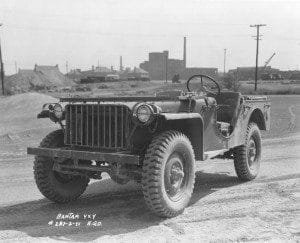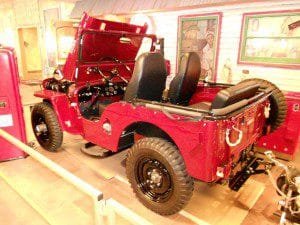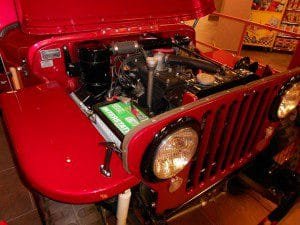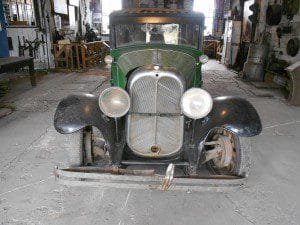One of the most versatile and long lasting brands that has survived the decades, and obviously remains very popular, is the Jeep. The Jeep brand had it’s start around 1940 as one of the most popular US military vehicles ever built. The Jeep brand has changed ownership several times, and changed designs many times as well, and continues to be one of America’s top selling brands.
The term “Jeep” was used to describe The Jeep MB or Willys MB. As is the case with some other car nameplates, the term “jeep” has a few different versions as to how it was arrived at. The first version is that army mechanics at one time used the term “Jeep” to describe any new untested vehicle.

Another version was that soldiers borrowed the name from the popular “Popeye” series which had a character named “Eugene the Jeep“. Yet another version says that the name was taken from Ford’s Gee-P. In fact, Ford ended up suing Willys-Overland in the 1940’s over use of the word. Ford wasn’t successful and the name stayed. Whichever is true, an perhaps it was some combination of these versions, the Jeep name stuck and became a household word.
The Willys-Overland Company’s roots went back to 1908 when John North Willys purchased the Overland Automotive Division of the Standard Wheel Company. Four years later he renamed the company Willys-Overland Motor Company. The Willys company had the same problems during the Great Depression years as did several other automakers. Willys-Overland filed for bankruptcy. At the end of the Great Depression, the company came out of bankruptcy with a new name, Willys-Overland Motors, Inc. Shortly thereafter, with the approaching storms of World War Two, Willys was fortunate to gain a military contract to build Jeeps. Willys utilized the designs from the American Bantam Car Company which had gone into bankruptcy.

It was Bantam that designed the first jeep and ended up building about 2,500 of them before ceasing operations. A man named Karl Probst working for Bantam is credited with the first design in 1940. The army set demanding specifications which included a 4×4 drive, a wheelbase of 75 to 80 inches, a fold down windshield, a 660 pound payload plus other attributes. At the same time, the Ford Motor Company was building their GPW to help the government meet it’s quota and during the war both Ford and Willys-Overland together satisfied the government’s contract. By the end of the war there were over 300,000 Jeeps built by Willys-Overland and about the same number of GPW’s by Ford. Jeeps also were very involved in both the Korean and Vietnam Wars.

As a side advantage for manufacturing so many military jeeps during the war, Willys-Overland received years of free publicity for their vehicles through news accounts of battles and landings. Pictures were transmitted showing the jeep being used by troops. The fame the vehicle attained during the war carried on for years afterward.
It was after the war that Willys-Overland Motor Company began building the new Jeep civilian model which they named the Jeep CJ. The company also came out in 1950 with their new Jeep military version which was called the M38. The new M38 was designed off the 1949 civilian jeep. With a history of building military vehicles during the war, it’s no surprise that the jeep name made car buyers think of ruggedness and durability.

As everyone knows, Jeep is now produced by Chrysler as a result of Jeep nameplate being taken over by other automakers during the 1950’s and 1960’s and beyond. Kaiser took over Willys-Overland in 1953 and changed the name to Willys Motor Company. In 1963 the name was changed again to the Kaiser-Jeep Corporation. In 1970, the American Motors Corporation took over the Jeep line from Kaiser-Jeep. In 1887 the American Motors Corporation was bought by Chrysler. Eventually, Chrysler was merged into Daimler-Benz. To this day, Jeep remains one of the most popular and best selling lines for the Chrysler Corporation.
It’s an understatement to say that there are many Jeep car clubs around the U.S. To emphasize how popular the jeep is today, not all of these clubs focus on the old Willys Jeep line and some are involved with the later year models. Other clubs are involved in off road driving which has always been a attribute for Jeep. The Military Jeepers Jeep Club has over 500 members. Their website is www.militaryjeepers.com. There is the Military Vehicle Collectors of California at website www.mvccnews.net. Another is the Green Mountain Military Vehicle Club at website http://www.angelfire.com/vt2/gmmvc/
Organizations such as the Green Mountain club feature a wide range of US military vehicles in addition to Jeep cars and trucks.
The fully and beautifully restored Jeep CJ shown in this article is on display at Russells Auto Museum and truck stop on Interstate 40 at Endee New Mexico. Endee is located just a few miles inside New Mexico from the Texas state line. Russells has a large fully restored collection of vintage and classic cars and trucks.
(Restored Willys Jeep photos from author’s private collection. World War Two Jeep photo from the public domain)


